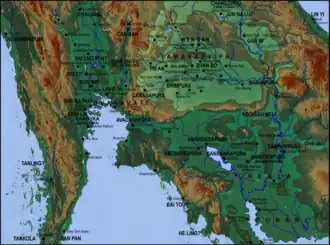Cān Bàn Kingdom
Cān Bàn Kingdom | |||||||||||
|---|---|---|---|---|---|---|---|---|---|---|---|
| 6th – 10th century? | |||||||||||
 Proposed locations of ancient kingdoms in Menam and Mekong Valleys in the 7th century based on the details provided in the Chinese leishu, Cefu Yuangui, and others. | |||||||||||
| Government | Kingdom | ||||||||||
| Historical era | Post-classical era | ||||||||||
| |||||||||||
| Today part of | |||||||||||
Cān Bàn Kingdom (Chinese: 参半国) or Sam Bun in Cantonese, which can be transliterated as Shampura, was a medieval petty Tai kingdom mentioned in the Chinese New Book of Tang and Cefu Yuangui. It was located more than a thousand li (500 kilometers) northwest of Wen Dan.[1]: 27 [2]: 41 [3] The city faces the sea or water, and the land is wet. To the southwest, it bordered the Bái Tóu Kingdom (白头国).[4]: 18 Cān Bàn sent tributes to the Chinese court in 625 and 628 CE.[2]: 40 [1]: 27, 35
During the Sui period (581–618), Cān Bàn and another kingdom, Zhū Jiāng — which has been identified as one of Dvaravati pricipalities[5] — made royal intermarriages with Zhenla. They then fought several wars against Tou Yuan to the northwest.[6] Tou Yuan later became a vassal of Dvaravati in 647.[7]: 269 [8]: 15–16 Through royal connections, Cān Bàn thereafter became a complete vassal of Zhenla[1]: 27, 35 until the disintegration in the late 7th century.[2]: 40
Japanese historian Tatsuo Hoshino places Cān Bàn in the upper Pasak Basin in the present-day Lom Sak—Lom Kao in Phetchabun province of Thailand,[2]: 45 and says it was an early city-state of Tai-speaking people — as the character 参 is pronounced sam1 in Cantonese, potentially linking to the Siamese, and 半 bun3 seems to correspond to the variants of the Sanskrit term "pūra", meaning town or city[2]: 39, 68 — that had a good relationship with the united Chenla, especially with the upper region of Wen Dan, at the time of Mahendravarman.[2]: 41 But after Wen Dan separated from Chenla in 681,[7]: 123 it was instead under Wen Dan.[2]: 40 Throught the migration, the kingdom of Cān Bàn expanded to the southwest and reached the sea around the 9th–10th century; thus, Hoshino placed the late Cān Bàn at the present-day Suphanburi, which is historically known as the Suphannaphum Kingdom.[2]: 42
In the 7th–8th century, in addition to Cān Bàn, the Tais also presented in other polities along the trans-Mekong trade route, including Wen Dan, Zhān Bó,[2]: 38–9 Gān Bì,[2]: 46 and the Changzhou prefecture (長州 or 裳州) of the Tang Dynasty in modern Sakhon Nakhon, Nakhon Phanom, Bueng Kan provinces of Thailand, and Khammouane province of modern Laos.[2]: 49–51
No further information about the Cān Bàn Kingdom has been found, and its identification remains disputed, as previous scholars place it to the northeast of the Cardamom Mountains, roughly near the present-day Battambang,[9]: 45–47 but this seems too close to Chenla, as the Chinese source indicates it is more than a thousand li (approximately 500 kilometers) away, and located northwest of Wen Dan.
References
- ^ a b c Fukami Sumio. "The Trade Sphere and the Tributary Business of Linyi (林邑) in the 7th Century: An Analysis of the Additional Parts of the Huangwang chuan (環王伝) of the Xintangshu (新唐書)" (PDF) (in Japanese). Archived from the original (PDF) on 14 December 2024. Retrieved 15 May 2025.
- ^ a b c d e f g h i j k Hoshino, T (2002). "Wen Dan and its neighbors: the central Mekong Valley in the seventh and eighth centuries.". In M. Ngaosrivathana; K. Breazeale (eds.). Breaking New Ground in Lao History: Essays on the Seventh to Twentieth Centuries. Chiang Mai: Silkworm Books. pp. 25–72.
- ^ Sharan, Mahesh Kumar (2003). Studies In Sanskrit Inscriptions Of Ancient Cambodia. Abhinav Publications. pp. 31–34. ISBN 978-81-7017-006-8.
- ^ "钦定四库全书: 册府元龟卷九百五十七宋王钦若等撰". Ministry of Foreign Affairs of the People's Republic of China (in Chinese). Retrieved 14 May 2025.
- ^ "朱江". www.world10k.com (in Chinese). Retrieved 17 May 2025.
- ^ "中国哲学书电子化计划". ctext.org (in Chinese). Retrieved 16 May 2025.
- ^ a b Lawrence Palmer Briggs (1950). "The Khmer Empire and the Malay Peninsula". The Far Eastern Quarterly. 9 (3). Duke University Press: 256–305. doi:10.2307/2049556. JSTOR 2049556. Archived from the original on 26 April 2024.
- ^ Geoffrey Goble (2014). "Maritime Southeast Asia: The View from Tang-Song China" (PDF). ISEAS – Yusof Ishak Institute. p. 1–19. ISSN 2529-7287. Archived from the original (PDF) on 2022-06-19.
- ^ Lawrence Palmer Briggs (1951). "The Ancient Khmer Empire" (PDF). Transactions of the American Philosophical Society. 4 (1): 1–295. doi:10.2307/1005620. JSTOR 1005620.